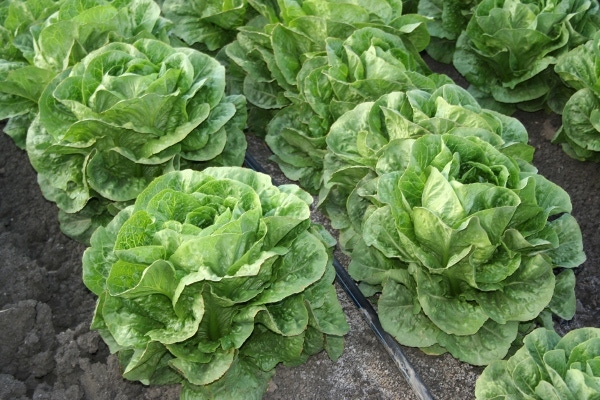
The foxglove aphid has been found in celery in Arizona’s Yuma Valley and in untreated lettuce at the Yuma Agricultural Center.Initial symptoms of lettuce dieback include extensive yellowing of the outermost leaves with the younger inner leaves usually remaining dark green in color.Few soil active herbicides are effective long enough to control weeds in vegetable seed crops.
January 13, 2012

The latest Arizona Vegetable Integrated Pest Management Update from the University of Arizona (UA) Cooperative Extension in Yuma, Ariz., released Jan. 12, 2012.
Foxglove aphids begin to colonize desert produce
By John Palumbo, UA Research Scientist and Extension Specialist
Until recently, aphid pressure has been relatively light in most areas throughout the desert Southwest. There have been a few reports of alate (winged) green peach aphids on a few plants with minimal colonization.
However, last week a local pest control adviser brought in some aphids for identification from a celery field in the Yuma Valley. The terminal area of the plant had several immature apterous (wingless) aphids colonized within the crown of the plant. The aphids were identified as foxglove aphids (FGA), Aulacorthum solani.
In addition, FGA have been found on untreated lettuce at the Yuma Agricultural Center.
The apterous forms are pear shaped and the abdomen is green in color. The cornicles are moderately long, thin, and tapered; varying in color from almost colorless to dark and with dark tips. The distinguishing characteristic of FGA is the dark green patches at the base of the cornicles.
In lettuce, FGA are serious pests of all spring lettuce types (leaf, romaine, and head) and typically begin showing up in January under mild weather conditions and are generally most active in February and March.
The FGA is more mobile than green peach aphid and tends to disperse more throughout the plant. However, insect tends to colonize intensively in heads and hearts once plants begin to cup.
FGA is a serious pest of celery primarily colonizing the young growth protected within the plant. They contaminate celery hearts at harvest rendering it unmarketable.
An application of Movento (spirotetramat) at 5 ounces/acre is the recommended insecticide for FGA in celery and in lettuce once plants have begun to form heads.
FGA does not colonize cole crops or spinach.
For more information on FGA and other aphid species found on leafy vegetables, click on this link: Insect Management on Desert Produce Crops: Aphids.
Remember, when in doubt , scout.
Contact Palumbo: (928) 782-3836 or [email protected].
Lettuce dieback
Lettuce dieback
By Mike Matheron, UA Extension Plant Pathologist
This disease has appeared in romaine plantings in southeastern Imperial County, Calif. and in Yuma, Ariz. over the past several years. Lettuce dieback also occurs in other lettuce production regions in California.
Initial symptoms on infected plants include extensive yellowing of the outermost leaves with the younger inner leaves usually remaining dark green in color. Dead spots on older leaves can develop into extensive areas of brown necrotic tissue.
As the disease progresses, plant stunting and death can occur. Rotted roots may also be present, but whether this is caused by the pathogens or is a secondary issue is not clear.
Lettuce dieback is caused by the Tomato bushy stunt virus and the closely related Lettuce necrotic stunt virus.
The disease is primarily a problem on romaine lettuce, although some green leaf, red leaf, and butterhead cultivars can be affected. To date, symptoms have not been observed in commercial plantings of crisphead lettuce.
Lettuce dieback is usually found in fields near rivers or low-lying areas that drain poorly. High salinity and plant stress will enhance lettuce dieback symptoms.
The viral pathogens can be dispersed by contaminated soil and water and can survive for a long period of time. No vectors for Tomato bushy stunt virus and Lettuce necrotic stunt virus are known.
Soil fumigation or crop rotation does not reduce disease severity in subsequent plantings of susceptible lettuce varieties.
Active research is in progress in California to develop commercial romaine varieties resistant to these two soil-borne viruses.
Contact Matheron: (928) 726-6856 or [email protected].
Weed control in vegetable seed crops
Weed control in vegetable seed crops
By Barry Tickes, UA Area Agriculture Agent
Season-long weed control in many vegetable seed crops is a challenge. Most fresh market vegetable crops are grown within two to four months and soil residual herbicides can control many annual weeds during the entire growing season.
Vegetable seed crops can be in the ground for eight months or longer. Few soil active herbicides are effective for this length of time. Even if there were herbicides that persisted this long, almost nothing is registered for use on these minor acreage, high-value crops.
Fields that are weed free now can look ugly by May when many of the crops are harvested. An application made now of a soil residual herbicide will help keep weeds in check until the crop is harvested. After the crop has made seed heads, cultivation equipment is difficult to fit into the field.
Growers should anticipate weed emergence emerging in the spring that will mature by harvest. Some of the emerging spring weeds, including clover, are the same size and weight as the crop seed (cole crops) and very difficult to clean out. Hand labor is the only weed control option.
Although few herbicides are registered for vegetable seed production, anything registered for use on that crop may be used unless the label specifically excludes use for seed production.
Contact Tickes: (928) 580-9902 or [email protected].
Can Bagrada bugs feed on seed?
John Palumbo was asked if the Bagrada bug feeds on seeds and can reduce a plant stand. Click this link for the answer: Bagrada Bug Seed Damage.
You May Also Like



